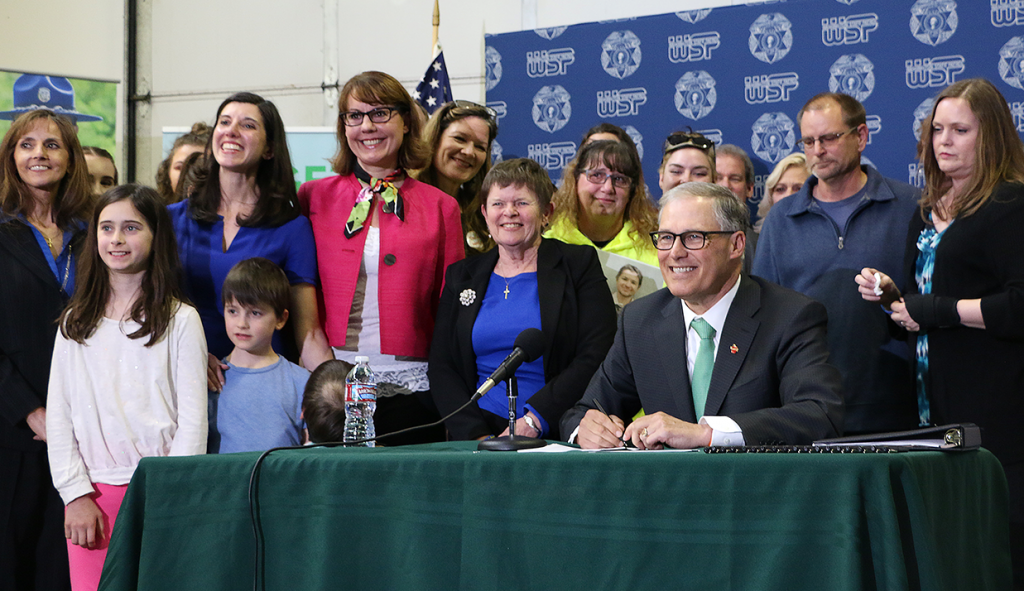

A new Washington state law closes loopholes and raises penalties related to cell phone use while driving, with the end goal of reducing car crashes, injuries and traffic jams.
Under the new legislation, drivers may use phones only with hands-free systems, such as Bluetooth headsets or dashboard clips. Cell phone distraction is prohibited even when a vehicle is stopped at an intersection, where crossing traffic, pedestrians and cyclists are at risk. Repeat offenders who continue to text and drive will face escalating fines, and distracted driving infractions are reportable to insurance companies. The law was signed on May 16 by Gov. Jay Inslee. At the signing, Inslee announced he had vetoed the law’s start date, meaning it will go into effect in 90 days instead of on Jan. 1, 2019.
The goal of the law is to change behavior and save lives, said Dr. Beth Ebel, transportation safety expert at the Harborview Injury Research and Prevention Center and professor of pediatrics at the University of Washington’s School of Medicine. She cares for injured children and teens at Harborview Medical Center, the regional trauma center.
“Every day I take care of children injured in preventable crashes: a toddler injured when her car was struck by a texting driver, or a 15-year-old teen crossing the street when he was hit by a distracted driver,” she said. “Our Harborview team will work miracles to save a child’s life. But it shouldn’t have happened. The only way to prevent these needless injuries and deaths is to come back and work with the legislature and the public.”
Ebel gave expert testimony to the Washington State Legislature regarding the law based on her research into distracted driving and her experience as a pediatrician. Her work includes a 2014 study where 9.5 percent of observed drivers in Washington state were distracted by a cell phone. The study, conducted by University of Washington and Harborview Medical Center, found that of those distracted drivers, two-thirds were texting. Texting increases a driver’s crash risk by a factor of 23, or the equivalent of drunk driving with a blood alcohol level more than twice the legal limit. Pedestrians and bicyclists are particularly at risk, Ebel said, and they make up about half of all driving fatalities in Seattle. She notes that distracted drivers act like drunk drivers, putting themselves and others in harm’s way.
Washington state has had a law banning texting and driving since 2007, the year when the first iPhone was released. Critics and police officers said the decade-old law was increasingly difficult to enforce and needed updates. As the capabilities of cell phones have grown, drivers using their phones to check email or post to social media were not breaking the law as written, even though those activities carry the same risks. The new law simplifies the rule – any driver interacting with their phone is in violation, excepting single-touch activation and deactivation or calls in emergency situations.
A number of groups advocated for the law, including state troopers, victims’ families, prosecutors and high school chapters of DECA, and Ebel noted that the broad range of dedicated supporters has been key to gaining legislators’ attention.
HIPRC Director Dr. Monica Vavilala said the new law reflects the center’s core mission.
“Injury prevention occurs at many levels, and public policy can be an important step to helping people make good choices about their safety,” she said. “Dr. Ebel’s work demonstrates the need to take action on distracted driving, and it’s gratifying to see academic research, law enforcement and community interest come together to enact change.”
Ebel said she hopes the new law will encourage drivers to plan ahead – such as by integrating hands-free technologies or setting up GPS routes before they start driving – in order to avoid a ticket. By taking precautions to avoid illegal distractions, drivers will make the roads safer for everyone.